About Bali
Bali, the perfect holiday destination for all ages, offers something for everyone.The primary gateway to Indonesia is the Sukarno-Hatta International Airport of Jakarta (also known as Cengkareng CKG), but there are increasingly more international airlines that offer direct flights to Bali. Find information on
he Indonesian currency is the Rupiah and you will become a millionaire the day you arrive. Once you have got your head around all the extra zeros it's fairly easy to work out the prices in your own currency. Bring travellers cheques or US $100 but be aware of the following: Notes must be the new ones with no tears or markings and many moneychangers are there to cheat you. Never change money where the moneychanger is operating a booth inside another shop. The rate is usually higher and you may be short changed by sleight of hand. Use establishments which are moneychangers only and count your money before you leave.
Taxis in the south are plentiful and cheap but make sure the driver turns on the meter. If he refuses and tries to set a price, get out and take another taxi. Usually the act of opening the door or demanding he let you out is sufficient for him to see the error of his ways. For longer trips you can negotiate for a minivan or Bemo but for two or three people a taxi is often the most comfortable and coolest choice. Bargain directly with a newish looking taxi and you will be surprised how cheap a 6-8 hour booking can be especially if you offer to top up his tank.Local buses are the cheapest way of getting about but they are hot and often overcrowded with people who could do with a shower. They also have the charming habit of stopping with no indication or attempt to move off the road so there is always the worry of a rear-ender from the following tailgater.
Providing you a valid International Drivers Licence you may rent a car or motorbike. Both are cheap by international standards but there are a couple of points you should be aware of. Road conditions are dangerous! Indonesians do not sit for a licence, they buy it. Accordingly driving skills are low. Nobody knows let alone obeys traffic rules and indications of turns and sudden stops are rarely given. Indonesians drive on the leftish side of the road, normally with one wheel over the centre line, and larger or older vehicles have right of way. I.e. Trucks and buses have right of way over cars, a beat-up Datsun has right of way over a BMW, and cars over motorbikes and cycles.
The roads around the southern tourist areas are busy but even the wonderful country roads have pitfalls such as dogs, children, chickens, loads of sand and the quaint habit of villagers sitting on the road for a chat.
In the event of an accident, as a visitor you will be accorded the courtesy of being at fault, no matter what the circumstances and you will be required to pay for any damage to either vehicle. As 100% concentration is required the driver doesn't see much of the scenery, so it is probably best to hire a car and driver, especially if your aim is a stress-free holiday!
The trend over the last few years is for air-conditioned shops with fixed prices including the major surfing labels, but there are still plenty of small street front places offering a dazzling array of merchandise from gaudy woodcarvings to cheap holiday clothing to something you will fall in love with. Spend some time poking around - it takes time to spot the gems amid the junk, but believe me there are gems for everyone to find.
Shoes, both men's and women's, handbags, men's business shirts, travel goods, CDs and surfwear should also be on your list.
Made to order clothing in both fabric and leather is another great buy. Bring your favourite jacket or suit and have it copied by a tailor or leather shop. Good quality at a very reasonable price.
Because labour is so cheap labour-intensive clothing is great value. Anything embroided, beaded or sequined is fantastically priced. So load up with party-wear!
There are some really stylish boutiques in Seminyak that are definately worth a look -it's cooler in the late afternoon, and then to Kura Kura Bar for a well earned drink.
Lately some great homeware shops have opened and arts and crafts abound. Fakes - watches, sunglasses, perfumes and clothing - are everywhere. Whatever you feel about fakes, the watches go, the sunnies look cool, the clothing wears and the perfume smells like its namesake for around two minutes. Don't buy the perfume except for someone you detest.
The newish shopping centre in the Galleria complex by the Kuta round about on the Sanur bypass is a stylish addition. While not fully occupied by any means it's breezy, peaceful and boasts a Matahari deparment store and supermarket, hair styling, books, CD's, fabric, homeware, restaurants etc, plus a Planet Hollywood.
Having sung the praise of Kuta, good shopping is also to be had at Nusa Dua and Sanur but without the depth or variety.
The
The
Located only 2 kilometers east of Java,
The beaches in the South consist of white sands, beaches in other parts of the island are covered with grey or black volcanic sand.
The wide variety of tropical plants is surprising. You'll see huge banyan trees in villages and temple grounds, tamarind trees in the North, clove trees in the highlands, acacia trees, flame trees, and mangroves in the South.
There are flowers, flowers everywhere. You'll see (and smell the fragrance of) hibiscus, bougainvilleas, jasmine, and water lilies. Magnolia, frangipani, and a variety of orchids are found in many front yards and gardens, along roads, and in temple grounds. Flowers are also used as decorations in temples, on statues, as offerings for the gods, and during prayers. Dancers wear blossoms in their crowns, and even the flower behind the ear of your waitress seems natural in
Elephants and tigers died out in
You can expect pleasant day temperatures between 20 to 33 degrees Celsius or 68 to 93 degrees Fahrenheit year-round. From December to March, the west monsoon can bring heavy showers and high humidity, but usually days are sunny and the rains start during the night and pass quickly. From June to September the humidity is low, and it can be quite cool in the evenings. During this time of the year you'll have hardly any rain in the coastal areas.
Even when it rains in most parts of
Most people live in the coastal areas in the South. The island's largest town and administrative centre is fast - growing Denpasar, with a population of over 370,000. The villages between the town of Ubud and Denpasar, Kuta (including Jimbaran, Tuban, and Legian, Seminyak, Basangkasa, etc), Sanur, and Nusa Dua are spreading rapidly in all directions, and before long the whole area from Ubud in the North to Sanur in the East, Berawa/Canggu in the West, and Nusa Dua in the South will be urbanised.
This southern part of
Important agricultural products besides rice are tea, coffee, tobacco, cacao, copra, vanilla, soy beans, chilly, fruit, and vegetables (there are now even vineyards near the northwest coast).
The new free-trade regulations will create some problems for
There is the combination of the friendly people, the natural attractions, the great variety of things to see and do, the year-round pleasant climate, and the absence of security problems. And then there is
As soon as you step off the plane you might sense the difference. In the villages you'll notice the quietness and wisdom in old people's faces, and the interest and respect in the young. Old men sit at the road side caressing their fighting cocks. Beautifully dressed women walk proudly through rice fields and forests carrying offerings on their heads to the next temple. There is the smell of flowers, and in the distance you hear the sound of gamelan music.
Gods and spirits have been an important part of
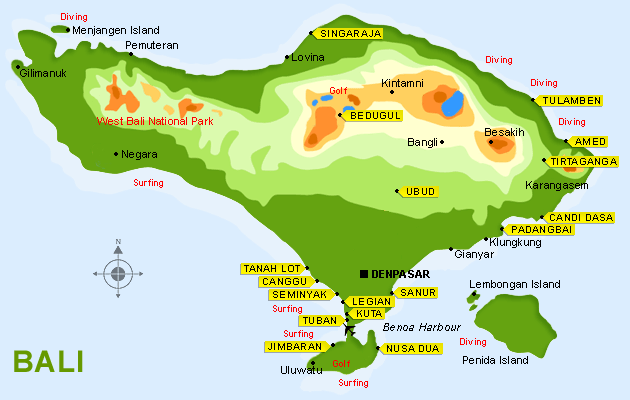




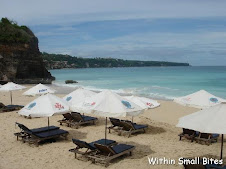

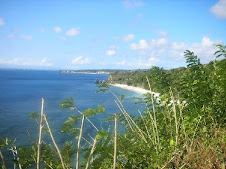





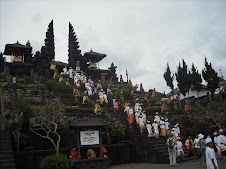
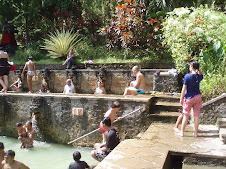
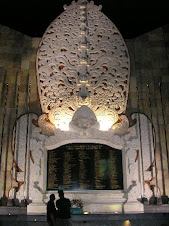


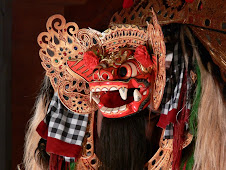
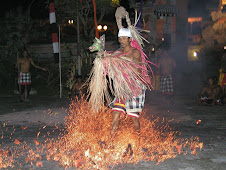



No comments:
Post a Comment